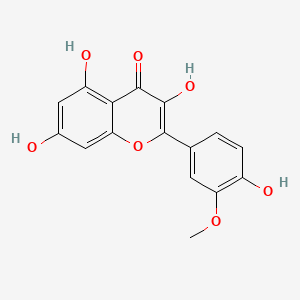| MeSH term | MeSH ID | Detail |
|---|---|---|
| Cystitis | D003556 | 23 associated lipids |
| Breast Neoplasms | D001943 | 24 associated lipids |
| Cataract | D002386 | 34 associated lipids |
| Parkinson Disease | D010300 | 53 associated lipids |
| Hypertension | D006973 | 115 associated lipids |
| Inflammation | D007249 | 119 associated lipids |
| Cell Transformation, Neoplastic | D002471 | 126 associated lipids |
| Hemolysis | D006461 | 131 associated lipids |
| Edema | D004487 | 152 associated lipids |
| Body Weight | D001835 | 333 associated lipids |
Isorhamnetin
Isorhamnetin is a lipid of Polyketides (PK) class. Isorhamnetin is associated with abnormalities such as Facial Hemiatrophy, Colitis, endothelial dysfunction, Morphologically altered structure and Diabetes. The involved functions are known as enzyme activity, Methylation, Anabolism, Binding (Molecular Function) and Vmax. Isorhamnetin often locates in Body tissue, Cytoplasmic, Mucous Membrane, Cytoplasm and Human tissue. The associated genes with Isorhamnetin are CSK gene, RPS6KA3 gene, Mitogen-activated protein, NCF1 gene and Chromatin. The related lipids are Fatty Acids, Phosphatidylserines and Palmitates. The related experimental models are Mouse Model, Xenograft Model and Streptozotocin Diabetes.
Cross Reference
Introduction
To understand associated biological information of Isorhamnetin, we collected biological information of abnormalities, associated pathways, cellular/molecular locations, biological functions, related genes/proteins, lipids and common seen animal/experimental models with organized paragraphs from literatures.
What diseases are associated with Isorhamnetin?
Isorhamnetin is suspected in Colitis, endothelial dysfunction, Morphologically altered structure, Facial Hemiatrophy, Diabetes, Hemorrhagic diarrhea and other diseases in descending order of the highest number of associated sentences.
Related references are mostly published in these journals:
| Disease | Cross reference | Weighted score | Related literature |
|---|
Possible diseases from mapped MeSH terms on references
We collected disease MeSH terms mapped to the references associated with Isorhamnetin
PubChem Associated disorders and diseases
What pathways are associated with Isorhamnetin
There are no associated biomedical information in the current reference collection.
PubChem Biomolecular Interactions and Pathways
Link to PubChem Biomolecular Interactions and PathwaysWhat cellular locations are associated with Isorhamnetin?
Visualization in cellular structure
Associated locations are in red color. Not associated locations are in black.
Related references are published most in these journals:
| Location | Cross reference | Weighted score | Related literatures |
|---|
What functions are associated with Isorhamnetin?
Related references are published most in these journals:
| Function | Cross reference | Weighted score | Related literatures |
|---|
What lipids are associated with Isorhamnetin?
Related references are published most in these journals:
| Lipid concept | Cross reference | Weighted score | Related literatures |
|---|
What genes are associated with Isorhamnetin?
Related references are published most in these journals:
| Gene | Cross reference | Weighted score | Related literatures |
|---|
What common seen animal models are associated with Isorhamnetin?
Mouse Model
Mouse Model are used in the study 'Chemopreventive activity of plant flavonoid isorhamnetin in colorectal cancer is mediated by oncogenic Src and β-catenin.' (Saud SM et al., 2013).
Xenograft Model
Xenograft Model are used in the study 'Isorhamnetin inhibits proliferation and invasion and induces apoptosis through the modulation of peroxisome proliferator-activated receptor γ activation pathway in gastric cancer.' (Ramachandran L et al., 2012).
Streptozotocin Diabetes
Streptozotocin Diabetes are used in the study 'Plant flavonol isorhamnetin attenuates chemically induced inflammatory bowel disease via a PXR-dependent pathway.' (Dou W et al., 2014).
Related references are published most in these journals:
| Model | Cross reference | Weighted score | Related literatures |
|---|
NCBI Entrez Crosslinks
All references with Isorhamnetin
Download all related citations| Authors | Title | Published | Journal | PubMed Link |
|---|---|---|---|---|
| Hyun SK et al. | Isorhamnetin glycosides with free radical and ONOO-scavenging activities from the stamens of Nelumbo nucifera. | 2006 | Arch. Pharm. Res. | pmid:16681033 |
| Choi CW et al. | Antioxidant constituents and a new triterpenoid glycoside from Flos Lonicerae. | 2007 | Arch. Pharm. Res. | pmid:17328234 |
| Jung HA et al. | Inhibitory activity of coumarins from Artemisia capillaris against advanced glycation endproduct formation. | 2012 | Arch. Pharm. Res. | pmid:22870812 |
| Kwon OS et al. | Inhibition of 5-lipoxygenase and skin inflammation by the aerial parts of Artemisia capillaris and its constituents. | 2011 | Arch. Pharm. Res. | pmid:21975819 |
| Nhiem NX et al. | A potential inhibitor of rat aortic vascular smooth muscle cell proliferation from the pollen of Typha angustata. | 2010 | Arch. Pharm. Res. | pmid:21191758 |
| An RB et al. | In vitro hepatoprotective compounds from Suaeda glauca. | 2008 | Arch. Pharm. Res. | pmid:18481014 |
| Xu J et al. | Antiinflammatory constituents from the roots of Smilax bockii warb. | 2005 | Arch. Pharm. Res. | pmid:15918511 |
| Choi JS et al. | Further isolation of peroxynitrite and 1,1-diphenyl-2-picrylhydrazyl radical scavenging isorhamnetin 7-O-glucoside from the leaves of Brassica juncea L. | 2002 | Arch. Pharm. Res. | pmid:12433194 |
| Oh HM et al. | Inhibitory activity of isorhamnetin from Persicaria thunbergii on Farnesyl Protein Transferase. | 2005 | Arch. Pharm. Res. | pmid:15789745 |
| Schulz HU et al. | Investigation of the bioavailability of hypericin, pseudohypericin, hyperforin and the flavonoids quercetin and isorhamnetin following single and multiple oral dosing of a hypericum extract containing tablet. | 2005 | Arzneimittelforschung | pmid:15727160 |
